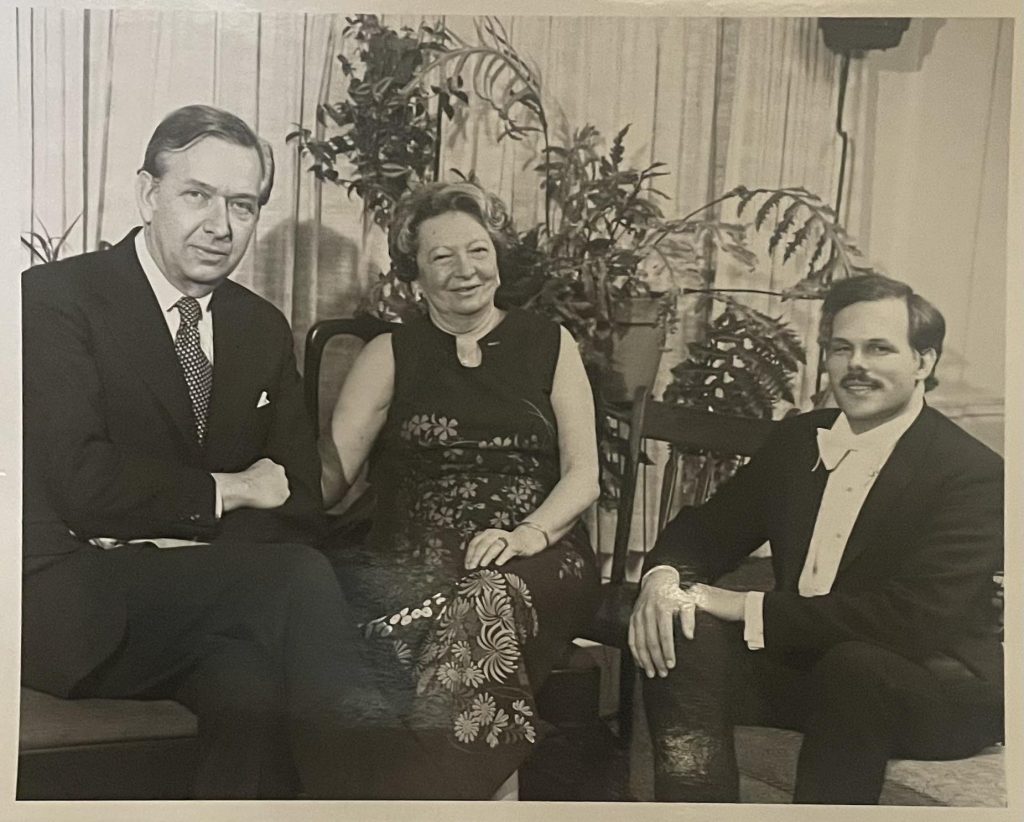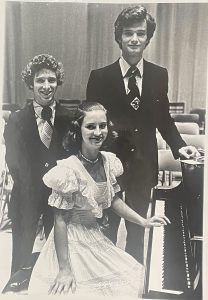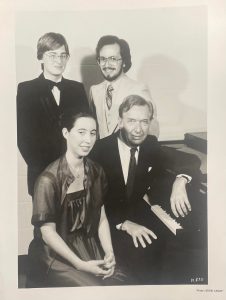
By Suzanna Feldkamp
Two famous pianists sit in a cafe, sipping espresso and reminiscing. It’s 1974 in New York City. One, Grant Johannesen, then Music Director of the Cleveland Institute of Music, was visiting the city to meet with an old mentor. This mentor was none other than Gaby Casadesus, the renowned French pedagogue and concert pianist, and as she sat across from him, they began to dream of ways to honor a loved one.
Gaby Casadesus had lost her husband two years earlier and her eldest son just months before that. Like many people do in times of grief, she seems to have managed by keeping herself busy. When a reporter asked how she could cope with the double loss, she replied, “’I went back to working—like a horse… Only three months after Robert’s death a concert date called and said ‘you have to replace your husband.’ I said oh, no, because we were to have played together. But I did and it saved my life’” (Alge, “Madame Casadesus—delightfully French,” The Cleveland Press).
Concertizing helped Gaby, but she, her family, and Grant—who had studied with Robert—wanted to do more, so that they didn’t merely cope with the loss but would carry on Robert’s memory and inspire others in the process. One or the other of them—we’ll never know exactly who—landed on the idea of a piano competition for up-and-coming pianists. The idea positioned the event in Cleveland, where Grant was based year-round and where Robert had also made great strides in his career. He had had a longstanding, close relationship with George Szell before Szell’s death, who had been conductor of the Cleveland Orchestra. Robert made over 20 recordings with Szell and the orchestra, so it seemed a fitting place for the competition.
But the two of them also knew that holding the competition in Cleveland would allow them to be close to other friends and garner the support of CIM. They brought the idea to Martha Joseph, the acting president of the conservatory, and Odette Valabregue-Wurzburger. Odette was a law professor at Case Western, but she was also a close friend from Paris who was devoted to art and culture on an international level. According to the 10th anniversary CIPC program, “The proposed project was received with great enthusiasm, and at a subsequent dinner meeting, the competition was born.”
Together, CIM staff and members of the Robert Casadesus Society planned and hosted the first Robert Casadesus International Piano Competition in 1975. They planned it to align with the Ravel centennial, since Robert had been the first to play Ravel in Paris and themed several competition-adjacent events around his works including a concert featuring some of the jurors. They faced some challenges along the way. In particular, they struggled to recruit international competitors. CIM had done extensive mailings to international conservatories, but the competition organizers were concerned. The cost of international travel would be a barrier, and if they did not reach applicants quickly, they would likely not have time to prepare the music.
It is unclear how they solved this issue, but by the time the competition came around there was a strong group of competitors from more than a dozen countries. For a first-time competition before the age of the computer, that is a big accomplishment in itself.
Of all the things to go wrong, none of the organizers thought of the weather. And yet, during the competition finals, there was a torrential downpour. Flooding wracked Cleveland, so badly that some people risked filling their cars’ floors with water by simply opening the doors. Despite the rain, every event had lines. Clevelanders braved the floods to make an appearance at the competition, which may have been dangerous but shows some spunk and a lot of dedication. According to Robert Finn of the Plain Dealer, “It was a splendid success, and a capacity audience sloshed through the high water to enjoy it.”
John Owings of the Oberlin piano faculty won the first prize. One of his prizes was to make a guest appearance with The Cleveland Orchestra, and his performance was met with praise. “In Liszt’s ‘Malediction’ Owings unleashed his not inconsiderable virtuosity on this strange and fascinating piece full of romantic fustian, with great contrasts between huge and dire chords and airy filigree passages. Owings was at all times fully in command of this material” (Hruby, “Craftsmanship Rules Concert,” Cleveland Press).
The competition was such a success that the founders almost immediately began planning for a second one. The organizers were ostensibly the same this time around: Martha Joseph seems to have taken on the majority of the responsibility, and she was assisted by Grant Johannesen, Mary Holliday (staff at CIM), and members of the family. The family was mostly involved in selecting music, because they were too far away to be much involved in the local organizing.
In part for this reason, they debated whether to move the affair to Paris every other competition year. It would allow the Casadesus to be more involved with the non-musical elements of the organizing, but it was also likely to increase the number of European contestants. In early 1976, the administration at CIM were informed that the 1977 competition might not be in Cleveland, but the possibility of moving to France seems to have been too complicated. While he does not mention specifics, Grant wrote in a letter of May 1977 that “The mechanics of moving the competition to France every two years posed tremendous problems.” Whatever these problems were, they tied the competition to Cleveland.
Staying in Cleveland allowed the organizers to focus on other priorities. Throughout 1976 and into 1977, the organizers sought membership in the Federation des Concours Internationaux de Musique, a Swiss-based network of international music competitions. It was important to become a member of the Federation because membership would categorize the competition as a serious opportunity for pianists, putting CIPC on the map for those interested in piano competitions worldwide. After being accepted to the Federation, the organizers recruited jury members, coordinated living accommodations for the competitors on campus, scheduled parties, lunches, and special events like another juror’s concert. CWRU agreed to host a film series, offering free admission to their showings of five French films.
Ultimately, location didn’t seem to deter international attention anyways. As Grant told Wilma Salisbury of the Plain Dealer, the competition practically followed him around the world. As she wrote, “When Grant Johannesen recently visited the Goethe Museum in Frankfurt, Germany, he saw a poster announcing the second biennial [CIPC] Aug. 22-28 at the Cleveland Institute of Music. When he visited Moscow Conservatory, he saw the same poster. When he stopped in London and Paris, he saw the familiar announcement again… ‘It does not mean dollars and cents for the city, but it redounds to Cleveland’s glory. The competition stands for something.’”
The second competition was just as successful as the first—and without the rain. In the first round, “Each young pianist was introduced anonymously and played for about half an hour. The front section of Kulas Hall was totally empty, with the judges ranged in a straight line in the row just behind the cross aisle. They followed scores, scribbled notes on memo pads and looked appropriately inscrutable.” (Finn, “Piano Test is Best Free Show,” The Plain Dealer). The youngest competitor of the whole competition took first prize. Nathalie Bera-Tagrine, 17. Critics praised her technical authority, her taste, well-thought-out interpretations, and fine feeling, and warm but unsentimental personality.

Documents show that the preparations for the third competition went just about the same as the second. However, there was a dramatic increase in interest in and applications, meaning that many more submissions had to be sifted through to select competitors. The organizers also had to be more specific about practicing arrangements because, apparently, they were worried about arguments between competitors. Each pianist was assigned their own practice room at the institute. Some had glorious windows to the sights of University Circle, and others were down in the basement. The former wasn’t as coveted as some might think—at least one pianist asked to be moved from the spacious, light upstairs room to the basement. (Salisbury, “Pressure Mounting Here for 32 Young Pianists,” The Plain Dealer).
The competition was steep. Looking at the publicity and results of 1979 proves it. “Contestants coped with their nerves in various ways,” pacing around outside, chatting with custodial staff, anxiously laughing with friends, and one joked to Salisbury, “’I’m not reaching for the Valium yet.’” (Salisbury, “Pressure Mounting,” P.D.). 39 competitors were invited to CIM, but only 32 ended up there. Two withdrew weeks before, five others simply didn’t show up. But the thinner competition didn’t yield any less spectacular winners.
1979’s medalist list is star studded. Angela Hewitt, Jean-Yves Thibaudet, and Edward Newman placed in the top three. All of them received high praise from the press. Newman, who placed first, was already preparing for an Alice Tully Hall debut later that year. Critics praised his sailing lines and the ease and authority he displayed at the piano. About Hewitt, Leonard Tartalgia wrote, “Whether spinning out a fine lyrical line, summoning up great strength for the crashing chordal passages, or cutting through Kulas Hall’s muddy acoustics with dazzling chromatic runs, she impressed one as an artist of great maturity and unique musicianship.” Regarding Thibaudet, Tartalgia continued, “His keyboard pyrotechnics generated considerable excitement and drew shouts of approval from those present.” (Tartaglia, “Everyone a Winner in Casadesus Piano Tourney,” The Plain Dealer).

In the years since 1979, the competition has only grown. From a $36,000 budget in the 1970s to one exponentially larger today, from dozens of applicants to hundreds, from a $2,000 first prize to a $75,000 first prize plus a huge package of additional services—everything indicates a commitment to finding the best new players and rewarding them with the greatest opportunities. Gaby and Grant had no way of knowing that their chat over coffee in 1974 would spark one of the top piano competitions in the world. Those early years laid the foundations for what came since, and what is yet to come.
Suzanna Feldkamp is a Ph.D. student in the musicology area at Case Western Reserve University. She has an M.A. and B.M. from Michigan State and conducts research on thirteenth-century French popular song.

